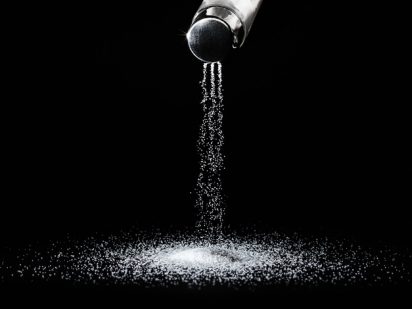Have you ever thought about how much salt you eat? If you’re like the average American, you consume more than 3,400 milligrams of sodium (the mineral in salt) each day, but adults are supposed to eat 2,300 mg or less, the amount in a single teaspoon of salt. In fact, the American Heart Association would prefer we stick to 1,500 mg or less each day.
Unfortunately, most Americans are used to a high-salt diet. The table shaker isn’t the main culprit, either; most of our sodium comes from packaged, processed foods.
Here’s why it’s a problem: Extra sodium in the bloodstream pulls water into the blood vessels, increasing the total amount of blood inside them, which leads to increased blood pressure. Over time, high blood pressure can overstretch or injure the blood vessel walls and speed the buildup of plaque that can block blood flow. This extra pressure makes the heart work harder.
High blood pressure is called the “silent killer” because it’s not usually obvious if you have it. It’s one of the major risk factors for heart disease, which kills more people worldwide than anything else. And 90 percent of American adults will develop high blood pressure over their lifetimes, according to the American Heart Association.
That’s why controlling sodium intake is so important.
“Your body need sodium, but in limited amounts,” says Desire’e Steinberger, RD, LRD, director of nutrition at Trinity Health.
Steinberger points out that for many people, “we don’t cook anymore” and instead depend on packaged or restaurant food, which tends to contain a lot of sodium.
People may be eating a lot of salt and not know it, Steinberger says. According to the Food and Drug Administration, more than 70 percent of sodium consumed comes from packaged, prepared, and restaurant foods. Additionally, the majority of daily sodium intakes comes from grains and meat, with processed poultry, soups, and sandwiches also contributing, the Centers for Disease Control and Prevention says.
For more information on Trinity Health’s Diabetes and Nutrition services, click here.
3 Ways to Eat Less Sodium
To lower sodium intake, try the following steps from Desire’e Steinberger, RD, LRD, director of nutrition at Trinity Health.
1) Eat fresh. In other words, cook at home. Cooking your own food puts you in control of what goes into it. The Department of Health and Human Services recommends that if you do use canned foods, “rinse them before eating or cooking with them,” as this will wash away some of the salt.
2) Know your ingredients. The Food and Drug Administration recommends looking at a product’s nutrition label to make informed decisions on sodium intake. The recommended daily value for sodium is less than 2,300 milligrams per day. As a general rule, 5 percent or less of the daily value of sodium per serving is considered low, and 20 percent or more is considered high. Be sure to check the serving size and the number of servings you eat or drink to determine how much sodium you are consuming.
3) Sub out the salt. Sometimes salt is needed for recipes such as bread, Steinberger says. However, in some cases, you can use an alternative.
“If you’re making a savory dish, exclude the salt and use Mrs. Dash seasoning,” Steinberger suggests. Also, instead of adding salt into a recipe as you cook, put the saltshaker on the table and sprinkle it in later.
“You don’t need salt in your water for pasta or potatoes,” Steinberger says.




